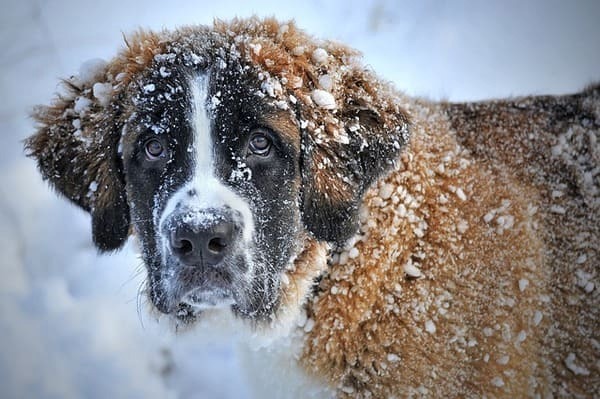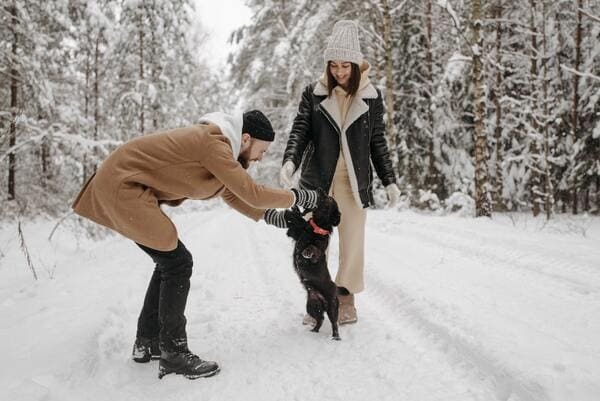

How to Keep Your Pet Safe in Cold Weather
The bitter winter months are as tough on pets as they are on pet owners. Read Animalia’s guide to keeping pets safe in even the coldest weather.

Writer Animalia Team
6 min read

Although winter is the perfect time to snuggle up with your furry friend and keep each other warm, stepping outside in the freezing temperatures can subject your pet to various potential risks. Before the thermometer dips, familiarize yourself with these winter pet safety guidelines to guarantee that your best friend stays safe and cozy all season long.
How cold is too cold for dogs and cats?
Keeping your pet safe despite scorching summer heat and blistering winter cold is an important part of responsible ownership. While some breeds of dogs and cats can tolerate the cold better than others, you should plan to keep a close eye on any type of pet when the temperature is low. The question is, how cold is too cold?
For cats and dogs, sustained exposure temperatures below about 50 degrees Fahrenheit can be dangerous. Generally, if the weather conditions are:
- 45℉ and below, your dog/cat will start experiencing discomfort due to the cold
- 32℉ and below, your old, sick, or thin-coated dog/cat should not be left outside at all
- 20℉ and below, your dog/cat will be exposed to severe hypothermia and frostbite if left outdoors for even a short period

In cold conditions, be sure to provide plenty of fresh water. Cold weather can cause a pet to become dehydrated much the same as hot weather. Beware of slippery surfaces on roads and sidewalks when it’s cold and snowy too. Just because they’ve got two extra legs to help them keep balance, doesn’t mean pets can’t slip, fall, and hurt themselves just like people.
Safety tips for pets in cold weather
As the temperature drops, your pet’s needs will rise. Here are some tips to help keep them safe and comfortable during the winter months:
1. Keep your pet sheltered from the cold
Keeping your pet sheltered means having a warm and dry place for them to stay while they spend time outdoors. If your cat or dog is used to spending time outside, make sure they have access to a heated shelter with plenty of insulation. Check on them regularly and take care to bring them inside at the first sign of trouble.

Second, provide plenty of warm, dry bedding. Invest in good-quality, thick bedding to keep your pet warm and cozy during cold winter days and nights. Be sure to check for signs of wear and tear regularly and to wash bedding as needed.
2. Don’t shave their fur
In hot or cold weather, it may be tempting to take dramatic steps and shave your pet’s fur. Fur is not your pet’s way of making a fashion statement, but instead plays a valuable role in insulating them from the elements and helping them retain body heat. Leave grooming to the professionals.
3. Use a winter coat
Pets look cute in cold weather outerwear and those adorable sweaters and coats are plenty helpful too. Investing in winter clothes for your pet can ensure they’re protected from wind and snow on walks or during playtime. Take time to measure your pet carefully to get the right size. Remember, even if your pet is wearing a winter coat and sitting in a sheltered area, the cold weather can still be hazardous.
4. Spend less time outside
During the colder months, keep a close eye on your pet any time they’re outside. This will help you spot any warning signs of hypothermia or frostbite. Ideally, you should aim to spend less time altogether during the winter while including a shelter for your pet to use any time they are outdoors.

5. Watch out for winter chemicals
Watch out for the chemicals found in salt and antifreeze mixture, which can be toxic to pets if ingested. Wipe up any spills immediately and keep pets away from treated surfaces. Clean your pet with warm water and dry them well if you suspect that they have come in contact with any potentially toxic winter chemicals.
Tip: Next time you head to the pet store, look for pet-friendly antifreeze chemicals to use in and around your home.
Brushing up on pet first aid before the cold weather hits is always a good idea. Knowing the signs of hypothermia and frostbite will help keep your pet safe if exposed to cold temperatures.
Recognizing and preventing hypothermia in pets
Hypothermia is a serious condition that can arise anytime a pet is exposed to cold temperatures for an extended period of time. It occurs when a pet’s core body temperature drops severely due to exposure to cold temperatures or immersion in cold water. Signs of hypothermia include:
- Shivering
- Lethargy
- Difficulty breathing
- Low heart rate
- Dilated pupils
- Low body temperature
- Loss of consciousness
If left untreated, hypothermia can quickly lead to organ failure and death.
Fortunately, there are ways to prevent this dangerous condition. First, ensure your pet has access to a warm, dry shelter in cold weather. If they are going to be outside for a prolonged period, consider buying them a coat or sweater to keep them warm. Keep them warm and dry and closely watch their activities and condition. Be ready to intervene and even contact the vet if they show signs of hypothermia or frostbite.
Frostbite in pets
Frostbite is another serious exposure-related medical condition that can have serious consequences if not treated promptly. It occurs when pets (or humans) are exposed to extremely cold temperatures for an extended period, leading to tissue damage and even death. The most common signs of frostbite in pets are pale, gray, or blue skin and fur, along with swelling and pain around the affected area.
Pet owners can take a number of steps to prevent frostbite:
- Make sure your pet is always properly clothed for cold weather and limit their exposure to extreme temperatures.
- Keep an eye on the temperature whenever your dog or cat is outside and bring them inside if it gets too cold.
- Avoid leaving your pet outside for long periods of time in cold weather. If your pet must be outside, it’s wise to have a warm, insulated shelter available.
If you suspect feline or canine frostbite, it’s important to warm the affected area gently and seek medical attention from your veterinarian immediately.
Pet insurance offers peace of mind in any weather. Get a quote from Animalia today and talk to one of our agents to learn more.





We offer the most
comprehensive coverage
out there
car with a spare tire for life’s bumps.
Having Animalia is like a pimped-out
Rolls Royce with a swimming pool
in the trunk.



Get your pet insurance quote
Pet type
- Dog
- Cat
What is your pet's name?
Zip code





